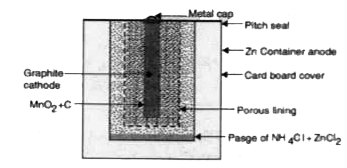What is a primary cell ? Describe the construction and working of dry cell,
Text Solution
Primary cells are those in which the electrode reactions cannot be reversed by an external electric energy source. In these cells, the reaction occurs only once and after use they become dead. Therefore, they are not chargeable.
(a) Dry cell. The dry cell was invented by G. Leclanche. It consists of a zinc cylinder. This is filled with a paste of NH4Cl and little of ZnCl2 in the form of paste in water. The zinc cylinder acts as anode. The cathode is a carbon rod. The carbon rod is surrounded by a black paste of manganese dioxide (MnO2) and carbon powder.
When the cell is operating, zinc loses electrons and Zn2+ ions dissolve in the electrolyte. The electrons pass. around the external circuit and are taken up at cathode. This causes discharge of NH+4 ions from the electrolyte.
The reactions occurring at the electrodes are given below :
At anode
Zn→Zn2++2e−
At cathode

2NH+4(aq)+2MnO2(s)+2e−→Mn2O3(s)+NH3+H2O
It gives a voltage of about 1.5 V.
(ii) Uses. The dry cells are used in torches, toys, flash lighters, calculators, tape-recorders and in many other devices.
|
Topper's Solved these Questions
- ELECTROCHEMISTRYBook:MBD -HARYANA BOARDChapter:ELECTROCHEMISTRYExercise:LONG ANSWER TYPE QUESTIONS
Explore 12 Videos
- ELECTROCHEMISTRYBook:MBD -HARYANA BOARDChapter:ELECTROCHEMISTRYExercise:VERY SHORT ANSWER TYPE QUESTIONS
Explore 12 Videos
- CHEMISTRY IN EVERYDAY LIFEBook:MBD -HARYANA BOARDChapter:CHEMISTRY IN EVERYDAY LIFEExercise:Long answer type questions
Explore 5 Videos
- GENERAL PRINCIPLES AND PROCESSES OF ISOLATION OF ELEMENTS Book:MBD -HARYANA BOARDChapter:GENERAL PRINCIPLES AND PROCESSES OF ISOLATION OF ELEMENTS Exercise:LONG ANSWER TYPE QUESTIONS
Explore 3 Videos
Similar Questions
Describe the construction and working of a periscope.
View SolutionExplain the construction and working of a dry cell.
View SolutionWhat are primary cells?
View SolutionWhat are primary cells?
View SolutionDescribe the construction and working of a Voltaic cell briefly.
View SolutionExplain the construction and working of 3 Nelson cell.
View SolutionExplain the construction and working of Westron standard cell.
View SolutionExplain the construction and working of Westron standard cell.
View SolutionPHOTOELECTRIC CELL
View SolutionPHOTOELECTRIC CELL
View Solution
